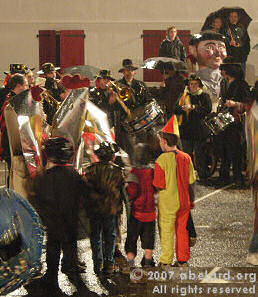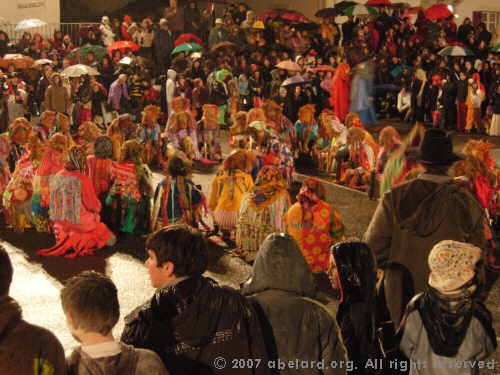











  |
 |
 |
 |
 |
|||
| site map |   |
 |
 |
 |
 |
||

|

mardi gras! carnival in Basque country |
 |
|
|
|
|||
francecathedral labyrinths and mazes in France cathedrals 9: saint-bertrand-de-comminges using metal in gothic cathedral construction Germans
in France on first arriving in France - driving France’s western isles: Ile de Ré Marianne - a French national symbol, with French definitive stamps the calendar of the French Revolution the French umbrella & Aurillac the
forest as seen by francois mauriac, and today after
the whirlwind, in les landes the Citroën 2CV: Pic du
Midi - observing stars clearly, A64 Carcassonne,
A61: world heritage fortified city Marianne - a French national symbol, with French definitive stamps the calendar of the French Revolution mardi gras! carnival in Basque country what a hair cut! m & french pop/rock country life in France: the poultry fair short biography of Pierre (Peter) Abelard
|
 Mardi gras is not slowed much by heavy rain. Note umbrellas in the Basque colours of red and green. Up in the Basque mountain town, it was a romp: 200-odd young people in
fancy dress skipping, drumming and banging to a green and red garbed,
face-painted conductor;
This all part of the ceremonies - chasing away evil spirits, a nuptial courtship, and local freedom protests. In this town where at least four of its citizens are currently French political prisoners (or terr0rists, if you’re a French policeman), was presented a highly political play about the French and Spanish governments, Italian maf1a and the catholic church, all ‘conspiring’ to obliterate the Basque nation. A destruction symbolised by the shutting down of local rail services by the French rail company (SNCF).
In 2007, the carnival included a display reminding observers that a local citizen is still on hunger strike after 106 days (apparently). The political play included protests about “the vice-president of our republic being imprisoned - we are not terr0rists!”
The final stage of this day’s carnival was the burning of Zanpantzar – the odious lover of feasts, symbol of the excesses of carnival – accompanied by enthusiastic communal Basque dancing around the ceremoniously lit bonfire (below).
The carnival parades through the streets from sunset, stopping here and there for playlets, cavorting and haunting Basque singing, culminating in the full-blooded show at the fronton, complete with a political play, story dancing, folk music and the ritual burning.
background to mardi grasMardi gras, French for fat Tuesday, is the last day before the start of the rituals called lent, which are performed by practicing members of the christianist sect. Lent recalls the 40 days that the teacher Jesus spent living sparsely in a desert. Mardi gras is also the day of carnival or carnaval, a word that comes from the expression, carne valem (latin for ‘goodbye to meat’). During lent, christianists used to abstain from meat and rich foods in imitation of their hero Jesus’s desert stay, now generally confined to ‘giving something up’ for lent. The christianist festival is overlaid onto pagan festivities. In ancient times, Egyptians, Greeks and Romans all had rowdy festivals. In the Roman Bacchanales, Saturnalia and Lupercalia, faces were masked and participants roved in disguise. During carnival, singing, dancing, disguises and masks chase away evil spirits, that may be burnt in effigy, as in the event above, all adaptations from pagan rituals. It is also a time of licenced naughtiness, a time that gives acceptance to sin behind the mask, a means of relieving the pressure cooker of repression while maintaining the stability of society. Mardi gras is the last fling and final day of licentious festivities before the thin times of lent [1]. In more primitive societies, this was the period when the winter stores of food for both humans and animals were running down. Then, people struggled to survive without the benefits of refrigerators and off-season products air-freighted in from warmer climes. Lent is a time for battening down, looking forward to the next spring, while wondering whether enough animals will survive, as their hay stores dwindles, into order to build up the herds as the sun returns. Shrove Tuesday is another name for this day, being the third day allocated (Shrovetide) for confession, doing penance and absolution of ‘sins’ - that is being shrived. In this anglo-saxon event, instead of masked entertainments, eggs, flour and oil are used in pancakes prior to forty days of semi-fasting.
In France, the treats of choice are beignets - huge doughnuts. The Frech eat crêpes - thin pancakes - on Candlemas, the 2nd February, a christianist feast marking the ‘purification’ of Mary and the presentation of Jesus when a baby. The French name for Candlemas is la Chandeleur. It is also known as the Fête de la Lumière or, of course, le jour des crêpes - Pancake Day! There is a tradition that if you successfully toss a crêpe using your right (writing) hand while holding a coin in the other hand, your family will be prosperous for the remainder of the year.
The date of Mardi Gras each year is calculated by the following:
end note
|
|
© abelard, 2004, 22 march the address for this document is https://www.abelard.org/france/mardi-gras.asp |